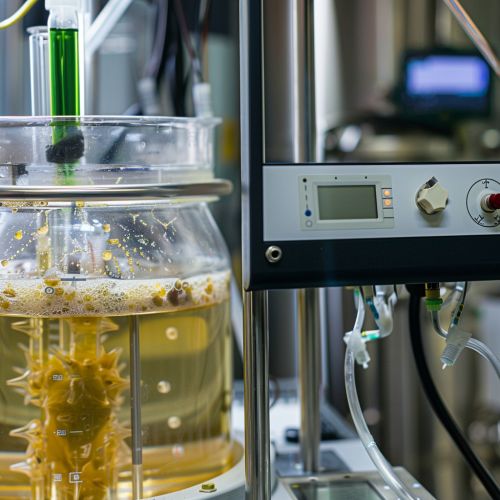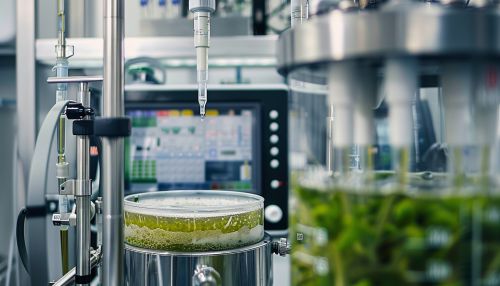Microbial Bioplastics Production Mechanisms
Introduction
Microbial bioplastics are a type of biodegradable plastic derived from renewable biomass sources, such as vegetable fats and oils, corn starch, or microbiota. Unlike traditional plastics, which are derived from petroleum, microbial bioplastics are produced by microorganisms, such as bacteria and algae, through various biological processes. These processes involve the conversion of organic substrates, such as sugars and lipids, into biopolymers, which are then processed into bioplastics.
Microbial Production of Bioplastics
The production of microbial bioplastics involves several stages, including microbial fermentation, biopolymer synthesis, and bioplastic processing.
Microbial Fermentation
Microbial fermentation is the initial stage in the production of microbial bioplastics. In this process, microorganisms, such as bacteria and algae, are cultured in a nutrient-rich medium, where they metabolize organic substrates, such as sugars and lipids, to produce energy and growth factors. The type of substrate used and the conditions of the fermentation process can significantly influence the type and yield of biopolymers produced.


Biopolymer Synthesis
Following microbial fermentation, the microorganisms synthesize biopolymers, which are long-chain molecules composed of repeating subunits. The most common types of biopolymers produced by microorganisms are polyhydroxyalkanoates (PHAs) and polylactic acid (PLA). PHAs are synthesized by a wide range of bacteria, including Pseudomonas spp. and Bacillus spp., while PLA is primarily produced by lactic acid bacteria. The synthesis of biopolymers is a complex process that involves several enzymatic reactions and is regulated by various genetic and environmental factors.
Bioplastic Processing
Once the biopolymers have been synthesized, they are processed into bioplastics. This involves the extraction and purification of the biopolymers from the microbial cells, followed by their conversion into plastic through various processes, such as extrusion, injection molding, and film blowing. The properties of the resulting bioplastics, such as their strength, flexibility, and biodegradability, can be tailored by modifying the processing conditions and adding various additives.
Factors Influencing Microbial Bioplastics Production
Several factors can influence the production of microbial bioplastics, including the type of microorganism used, the substrate and nutrients provided, the conditions of the fermentation process, and the genetic and metabolic engineering of the microorganisms.
Microorganism Selection
The selection of the microorganism is a crucial factor in the production of microbial bioplastics. Different microorganisms have different metabolic capabilities and can produce different types of biopolymers. For example, Pseudomonas spp. and Bacillus spp. are known for their ability to produce PHAs, while lactic acid bacteria are known for their ability to produce PLA. Furthermore, some microorganisms can produce biopolymers from a wide range of substrates, while others are more substrate-specific.
Substrate and Nutrient Provision
The type and concentration of the substrate and nutrients provided can significantly influence the yield and quality of the biopolymers produced. For example, sugars and lipids are commonly used as substrates for the production of PHAs and PLA, respectively. However, the use of waste materials, such as agricultural residues and industrial byproducts, as substrates for microbial bioplastics production is gaining increasing attention due to their abundance and low cost.
Fermentation Conditions
The conditions of the fermentation process, such as the temperature, pH, and oxygen level, can also affect the production of microbial bioplastics. Optimal fermentation conditions can enhance the metabolic activity of the microorganisms, increase the yield of biopolymers, and improve the properties of the resulting bioplastics. However, the optimal conditions can vary depending on the type of microorganism and biopolymer.
Genetic and Metabolic Engineering
Genetic and metabolic engineering techniques can be used to enhance the production of microbial bioplastics. These techniques involve the modification of the genetic and metabolic pathways of the microorganisms to increase their biopolymer synthesis capacity, improve their substrate utilization efficiency, and tailor the properties of the biopolymers produced. For example, the introduction of PHA synthesis genes into non-PHA-producing bacteria can enable them to produce PHAs, while the modification of the PHA synthesis pathway in PHA-producing bacteria can increase their PHA yield and alter the composition of the PHAs produced.
Applications of Microbial Bioplastics
Microbial bioplastics have a wide range of applications, including packaging, agriculture, medicine, and electronics.
Packaging
Microbial bioplastics are widely used in packaging due to their biodegradability and renewable nature. They can be used to produce various types of packaging materials, such as films, bottles, and containers, which can degrade naturally in the environment, reducing plastic pollution.
Agriculture
In agriculture, microbial bioplastics can be used to produce biodegradable mulch films, seed coatings, and controlled-release fertilizers. These products can improve agricultural productivity, reduce labor costs, and minimize environmental impact.
Medicine
In medicine, microbial bioplastics, particularly PHAs, have been used to produce biodegradable sutures, drug delivery systems, and tissue engineering scaffolds. These products can degrade naturally in the body, eliminating the need for surgical removal and reducing the risk of complications.
Electronics
In electronics, microbial bioplastics can be used to produce biodegradable electronic devices, such as sensors, actuators, and transistors. These devices can degrade naturally in the environment, reducing electronic waste.
Conclusion
Microbial bioplastics represent a promising alternative to traditional plastics due to their biodegradability and renewable nature. The production of microbial bioplastics involves several stages, including microbial fermentation, biopolymer synthesis, and bioplastic processing, and is influenced by various factors, such as the type of microorganism used, the substrate and nutrients provided, the conditions of the fermentation process, and the genetic and metabolic engineering of the microorganisms. Microbial bioplastics have a wide range of applications, including packaging, agriculture, medicine, and electronics, and their development and utilization can contribute to the transition towards a more sustainable and circular economy.
